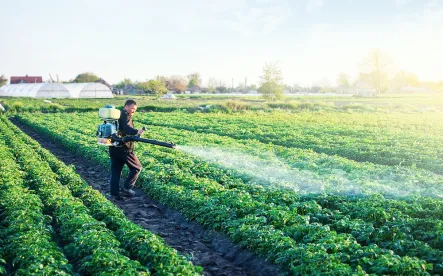On March 13, 2023, the U.S. Environmental Protection Agency (EPA) issued a proposed rule that would update the pesticide Application Exclusion Zone (AEZ) requirements under the 2015 Agricultural Worker Protection Standard (WPS). 88 Fed. Reg. 15346. The proposed rule is available at EPA-HQ-OPP-2022-0133, and comments on the proposed rule are due on or before May 12, 2023.
Application Exclusion Zone
According to EPA’s press release, the WPS regulations offer protections to over two million agricultural workers and pesticide handlers who work at over 600,000 agricultural establishments. In 2015, EPA made significant changes to the standard to decrease pesticide exposure among farmworkers and their family members.
Among the changes, the revised standard includes a new provision requiring agricultural employers to keep workers and all other individuals out of the AEZ area during outdoor pesticide applications. The AEZ is the area surrounding an ongoing pesticide application that people must not enter to avoid exposure. EPA states that an AEZ moves with the equipment during applications to protect farmworkers and bystanders that could be contacted by pesticides.
In 2020, EPA published a rule specific to the AEZ requirements, limiting the applicability of the protections to the agricultural employer’s property and shrinking the AEZ size from 100 feet to 25 feet for some ground-based spray applications. Prior to the effective date of the 2020 AEZ Rule, petitions were filed in the U.S. District Court for the Southern District of New York (SDNY) and in the U.S. Second Circuit Court of Appeals challenging the 2020 Rule. The SDNY issued an order granting the petitioners’ request for a temporary restraining order. As a result, the 2020 AEZ Rule has not gone into effect, and the AEZ provisions in the 2015 WPS remain in effect.
EPA states that it determined the provisions in the 2020 AEZ Rule weakened protections for farmworkers and nearby communities from pesticide exposure and should be rescinded to protect the health of farmworkers, their families, and nearby communities.
Proposed Changes and Flexibilities
EPA is proposing to reinstate several provisions from the 2015 WPS, including:
-
Applying the AEZ to:
-
Beyond an establishment’s boundaries; and
-
When individuals are within easements (such as easement for utility workers to access telephone lines).
-
-
Establishing AEZ distances for ground-based spray applications of:
-
25 feet for medium or larger sprays when sprayed from a height greater than 12 inches from the soil surface or planting medium; and
-
100 feet for fine sprays.
-
Additionally, EPA is proposing to retain two provisions in the 2020 AEZ Rule that it believes are consistent with the intent of the 2015 WPS AEZ requirements and, according to EPA, are supported by information available that provides more clarity and flexibility for farming families. EPA proposes to retain:
-
A clarification that suspended pesticide applications can resume after people leave the AEZ; and
-
An “immediate family exemption” that allows only farm owners and the farm owners’ immediate family to remain inside enclosed structures or homes while pesticide applications are made, providing family members flexibility to decide whether to stay on-site during pesticide applications, rather than compelling them to leave even when they feel safe remaining in their own homes.
Commentary
The 2015 WPS rule made significant changes and enhancements to the original 1992 WPS program and represented years of review and consideration of significant changes to the earlier rules. For the most part, by the end of that rule-gestation process, most changes were not considered controversial even as various stakeholders criticized or were dissatisfied by the final rule. Nonetheless, as the Trump Administration arrived in 2017, it considered revisions to the 2015 WPS rule in three areas: the minimum age of workers, the ability for a worker to designate a third-party representative to have the right to review application records if there was an inquiry related to a possible pesticide-related injury, and the AEZ provisions. During this time that the Trump Administration considered and proposed changes, reauthorization of the pesticide industry fee law, the Pesticide Registration Improvement Act (PRIA), was moving through Congress. Proposed to be part of the 2018 Farm Bill, the PRIA reauthorization legislation was held up by Senator Udall (D-NM) over concerns about what he considered changes that would unacceptably weaken the 2015 WPS program.
This part of the saga came to an end when Senator Carper (D-DE), as Chair of the Senate Environment Committee, exchanged letters with the Trump Administration that promised no changes to the WPS requirements except for consideration of the AEZ provisions in exchange for allowing certain EPA appointee nominations to be considered for a confirmation vote. This is worth noting since it was an explicit exchange of correspondence and not a more typical “informal” agreement between Administrations and Senators regarding confirmation votes. Eventually, the Trump Administration proposed and eventually issued only revisions to the AEZ requirements to, according to statements at the time, clarify and simplify the 2015 rule provisions. It is those revisions that are now being changed in this 2023 rule.
In the end, these 2023 revisions mostly revert the AEZ requirements back to the 2015 regulation requirements. They do include some additional elements of the 2020 changes to respond to stakeholder concern elements of the provisions to clarify more precisely how to protect bystanders. As a result, these regulations continue to implement two of the declared priorities of the Biden Administration: (1) increased emphasis on environmental justice concerns; and (2) to review and likely reverse decisions made by the Trump Administration considered to be not sufficiently protective and/or not sufficiently justified by the underlying factual basis relied upon by the previous Administration.




 />i
/>i

